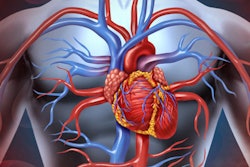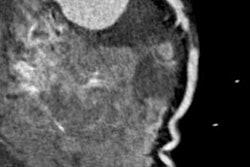
Using coronary CT angiography (CCTA) instead of SPECT myocardial perfusion imaging (MPI) to diagnose coronary artery disease (CAD) can significantly reduce the number of patients referred for invasive procedures, according to an article published online in Scientific Reports.
The researchers, led by Dr. Joseph Schoepf from the Medical University of South Carolina (MUSC), assessed the diagnostic accuracy of CCTA for patients suspected of having CAD and ultimately referred for cardiac catheterization because of abnormal results on SPECT MPI. CCTA proved to have much better diagnostic yield than SPECT MPI with accuracy nearly as high as cardiac catheterization. What's more, CCTA was safely able to rule out invasive follow-up testing for 46 out of 100 patients referred by SPECT MPI (Sci Rep, June 15, 2018).
"By inserting cardiac CT angiography more into the clinical algorithm for suspected CAD, there's a lot we can do to tighten healthcare efficiency," Schoepf told AuntMinnie.com. "We could obviate the need for unnecessary MPI if we used CCTA as a first-line test and also reduce the number of invasive coronary angiograms that are not associated with any necessary clinical intervention."
Breaking with tradition
 Dr. Joseph Schoepf from MUSC.
Dr. Joseph Schoepf from MUSC.Numerous studies have confirmed the high diagnostic accuracy of CCTA for obstructive CAD, as well as its potential to reduce the risk of complications and hospital stays and even help predict heart attacks. Yet CCTA continues to play second fiddle to other diagnostic tests, namely, SPECT myocardial perfusion imaging, which has far and away remained the most commonly used test for diagnosing coronary disease in the U.S.
The reason behind this sluggish shift in imaging protocol may be more a matter of custom and politics than lack of evidence, according to Schoepf.
"The use of MPI with SPECT is a traditional and generational issue," he said. "It's a test that many people are still familiar with because it's what they've used all their life ... and it was lavishly reimbursed in previous years. We will see a change in its use as newer generations of physicians move in who, during their training, are more exposed to advanced techniques."
Currently, the usage rate of CCTA is gradually trending upward, particularly for radiologists, who now use the test more so even than cardiologists.
No single testing strategy has been established as the best method for diagnosing obstructive CAD as of yet, the authors noted. But how might the yield and accuracy of detecting CAD be improved? And should unique patient subsets, such as high-risk patients, be evaluated differently?
To answer these questions, the researchers evaluated the effectiveness of using CCTA for patients with a high risk of having obstructive CAD -- specifically, patients who had an abnormal SPECT MPI test and a referral for cardiac catheterization.
"The old mantra is that cardiac CT is best used for patients at low to intermediate risk, but we wanted to break with that mold," Schoepf said. "The algorithms utilized to determine pretest likelihood for obstructive CAD are outdated and likely not qualified to determine the risk level of patients."
Fewer invasive interventions
In this prospective study, the group examined 100 patients at either MUSC or the Ralph H. Johnson Veterans Affairs Medical Center between September 2008 and September 2013 who presented with chest pain or shortness of breath. Due to abnormal findings on SPECT MPI, each of the patients received a referral for cardiac catheterization, which they had after first undergoing a CCTA exam. The patients were predominantly male (84%) and Caucasian (69%), and they had an average age of 59.6 years.
A nuclear medicine physician or nuclear cardiologist independently examined the SPECT MPI studies. Two radiologists reviewed the CT angiograms and reported potential obstructive CAD when there was at least 50% stenosis in a major vessel. And two interventional cardiologists assessed the cardiac catheterization results, with clinically significant disease defined as 50% or greater stenosis in the left main coronary artery or 70% or greater diameter narrowing in any major vessel.
Among the 100 patients suspected of having obstructive CAD on SPECT MPI and referred for invasive intervention, cardiac catheterization confirmed stenoses in 45 cases. CCTA identified all 45 cases and an additional nine false positives for a total of 54. In other words, CCTA could have prevented 46 patients from undergoing an unnecessary invasive procedure, without missing a single case found with the reference standard.
| CCTA vs. MPI for diagnosing obstructive coronary artery disease | ||
| MPI | CCTA | |
| No. of patients requiring subsequent cardiac catheterization | 100/100 | 54/100 |
The data also revealed that CCTA had excellent diagnostic accuracy for clinically significant CAD compared with cardiac catheterization.
| Diagnostic yield of CCTA for coronary artery disease | |||||
| Sensitivity | 100% | ||||
| Specificity | 83.6% | ||||
| Negative predictive value | 100% | ||||
| Positive predictive value | 83.3% | ||||
Furthermore, older age turned out to be a statistically significant predictor of obstructive CAD on CCTA; on average, patients with a positive CCTA were 61.9 years old and those with a negative CCTA were 57 years old (p = 0.0052).
CCTA as gatekeeper
CCTA can effectively rule out cases of coronary disease requiring intervention, whereas functional stress testing might be able to predict risk but is a weak determinant of obstructive CAD, the authors noted. As such, a significant number of invasive coronary procedures could potentially be avoided if CCTA was used as the first diagnostic imaging test in this higher risk patient population. This approach may become even more important as future functional CT technologies continue to develop.
As a recent example, Schoepf and colleagues demonstrated in a separate study how they were able to refine the diagnostic accuracy of CCTA for CAD with the aid of a machine-learning CT fractional flow reserve algorithm -- particularly by reducing the number of false positives detected on CCTA (Circulation: Cardiovascular Imaging, June 2018, Vol. 11:6, e007217).
With awareness of CCTA's advantages on the rise, more clinicians will turn to the test as a safe and powerful method for boosting diagnostic accuracy and saving money in the treatment of patients suspected of having obstructive CAD, Schoepf said.
"I believe we'll see a very strong change favoring CCTA," he said. "We already see it in countries with more regulated healthcare economies such as the U.K., where CCTA is the entrance test for people suspected of having CAD. I don't think that the U.S. will necessarily copy this formula ... but it heralds a stronger move toward CCTA."




















